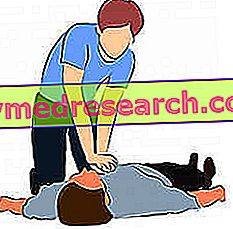Generality
Cardiac arrest, also known as sudden cardiac death, is a serious emergency situation, characterized by the sudden and sudden cessation of the pumping of the heart, the loss of consciousness and the absence of breath.

To save the life of those suffering from cardiac arrest, rescuers must act immediately and clearly. In fact, death and permanent damage to some organs of the body (for example the brain) can occur as soon as a few minutes later.
Sinus rhythm and arrhythmias
The heart is an organ formed by a particular muscle, called myocardium, capable of generating and conducting the impulses for the contraction of the atria and the ventricles. The source of these impulses, which are comparable to electrical signals, is found at the level of the right atrium of the heart and is called the atrial sinus node .
The atrial sinus node has the task of marking the right frequency of contraction of the cardiac organ, so as to guarantee a normal heart rhythm. The normal heart rhythm is also called sinus rhythm .
A cardiac arrhythmia is an alteration of the normal heart rhythm, which can become faster, slower or assume an irregular frequency.
What is cardiac arrest?
Cardiac arrest is a clinical emergency condition, characterized by the sudden and unexpected interruption of cardiac activity and the loss of knowledge and respiratory capacity.
It is so severe that, if it does not intervene immediately, within a few minutes it causes permanent damage to the brain and the death of the affected individual.
Due to its characteristics of suddenness, unpredictability and lethality, cardiac arrest is also called sudden cardiac death or sudden cardiac arrest .
CARDIAC ARREST AND HEART ATTACK ARE THE SAME WHAT?
Many often identify cardiac arrest with heart attack (commonly called heart attack).
However, they are two different disorders, as they have a distinct nature: at the origin of the heart attack there is an interruption of the blood flow directed to the myocardium; at the origin of cardiac arrest, however, there is an alteration of the sinus rhythm, or an arrhythmia.
Epidemiology
According to a statistical study, in countries such as Italy or the United States, cardiac arrest has an annual incidence of one case per 1, 000 inhabitants and high mortality (the survival rate, in the absence of any therapeutic treatment), is 2%).
Moreover, it is more frequent among middle-aged people (in young people it is linked to particular congenital defects of the heart) and prefers the male sex (the relationship with women is 3 to 1).
| Cases per year | 1 in 1000 |
Cases per year in Italy | About 60, 000 |
Cases per year in the USA | About 320, 000 |
Survival rate | 2% |
Survival if defibrillation occurs within 5 minutes | 50% |
Time to defibrillate (see the chapter on therapy) | Maximum 4-6 minutes |
From what age is its occurrence most likely? | From the age of 45, for the man, and from the age of 55 for the woman |
How many deaths from cardiovascular disease are due to sudden cardiac death | Over 50% |
Causes
A cause of cardiac arrest is an anomaly in the conduction of electrical signals that normally, starting from the atrial sinus node, contract the heart. In other words, the cause of cardiac arrest is an arrhythmia capable of interrupting the normal activity of the heart.
DO ALL ARYTHMIES CAUSE A HEART RATE?
Arrhythmias are unusual and out of the ordinary, but they do not always cause cardiac arrest.
They have a potentially lethal effect when, with their changes, they dramatically interrupt the natural cardiac function of pumping blood.
A classic example of arrhythmia capable of causing cardiac arrest is ventricular fibrillation .

Figure: ventricular fibrillation
This is characterized by such a profound alteration of the heart rhythm, that the heart, instead of contracting and pumping the blood towards the various organs of the body, vibrates in a completely useless way.
Dangerous arrhythmias like ventricular fibrillation usually appear when an individual suffers from severe heart disorders.
HEART DISORDERS ASSOCIATED WITH CARDIAC ARREST
The heart disorders (or heart diseases) that can lead to cardiac arrest are:
- Coronary heart disease . Coronaries are the arterial vessels that oxygenate the myocardium. Their obstruction, for example due to the deposit of cholesterol, can block the internal blood flow and thus interrupt the oxygenation of the myocardium. Deprived of oxygen, the heart is more difficult to work properly and is more prone to develop serious arrhythmic episodes. Coronary heart disease is the cause of most cardiac arrests.
- The heart attack . Earlier it was specified that heart attack and cardiac arrest are two distinct pathological situations. This, however, does not exclude that cardiac arrest may result from the heart attack; often, in fact, the heart attack is subsequent to a coronary heart disease, which, as mentioned above, can upset the electrical system of the human heart muscle.
- Dilated cardiomyopathy . The term dilated cardiomyopathy identifies a disorder characterized by thickening of the walls of the heart, in particular the walls of the ventricles. This thickening can cause a variation in the conduction of electrical impulses, hence an arrhythmia.
- Heart valve abnormalities . The heart has four valves, which finely control the flow of blood through the atria and ventricles. Their malformation can affect the onset of an arrhythmia, such as to cause a arrest of cardiac functions.
- Congenital anomalies of the heart . Some individuals are born with a malformed or imperfect heart. These individuals are predisposed to develop various heart problems, including cardiac arrest. Congenital heart abnormalities are among the main causes of sudden cardiac death in children and adolescents.
- Brugada syndrome and long QT syndrome . The heart of people suffering from these two syndromes has an abnormal electrical system. This can cause, in some unfortunate cases, the sudden onset of a cardiac arrest.
RISK FACTORS
The picture of risk factors is very broad. A complete overview of the favoring situations is shown in the following table:
|
|
NB: to underline the strong link between coronary heart disease and cardiac arrest, the risk factors common to both of these disorders have been reported on the left column.
Symptoms and Complications
To learn more: Symptoms Cardiac arrest
The most characteristic symptoms of cardiac arrest are: cardiovascular collapse, lack of pulse, breathlessness, unconsciousness, convulsions and pale cyanosis .
These symptoms usually arise without any warning and unexpectedly, although, in some rare situations, they can be preceded by fatigue, a sense of fainting, loss of the senses, dizziness, chest pain, shortness of breath, palpitations and vomiting.
The sudden onset of symptoms is the property that makes cardiac arrest highly lethal.
COMPLICATIONS
During a cardiac arrest, the various anatomical districts of the body no longer receive oxygenated blood and begin progressively, and within a short time, to become damaged.
The first organ concerned is the brain, which, in the absence of relief, can suffer permanent damage after 4-6 minutes.
Death can come just as quickly; in fact, it is very rare that after 10 minutes the patient is still alive (and even if he were, he would have brain damage incompatible with a normal life or would be in a coma).
Based on this schedule, it is possible to understand how essential it is, during a cardiac arrest, to intervene immediately and with the most appropriate treatments.
WHEN TO REFER TO THE DOCTOR?
Predicting or preventing cardiac arrest is somewhat complicated. Moreover, its onset is so rapid that it does not give the possibility to contact a doctor in time.
However, if an individual frequently suffers from chest pain, heart palpitations, irregular heartbeat, tachycardia (ie rapid heartbeat), difficulty breathing and a sense of fainting, it is good that he requires a medical consultation and undergoes an accurate cardiological examination. In fact, a predisposition to cardiac arrest may emerge from it.
Diagnosis
The first thing to do, in the event of cardiac arrest, is to provide immediate relief to the affected individual. Therefore, every diagnostic examination and every investigation relating to the triggering causes (coronary heart disease, heart attack, etc.) is postponed to a later phase and if the patient survives.
The investigations to be carried out are numerous and consist of:
- An electrocardiogram
- Blood tests of various kinds
- Diagnostic imaging
- Other types of exams
The data emerging from their execution could enable existing heart diseases to be treated and prevent a second episode of cardiac arrest.
ELECTROCARDIOGRAM
The electrocardiogram measures the electrical activity of the heart. By applying some electrodes on the chest and limbs, it is possible to measure the heart rate and any sinus rhythm disturbances.
It is a particularly useful control in cases of cardiac arrest due to heart attack.
BLOOD TESTS
Blood tests are aimed at measuring and / or looking for: cardiac enzymes, electrolytes, pharmacological substances and hormones.
- Search for cardiac enzymes . Following a heart attack, enzymes that normally are present only in the heart spread into the blood. Since a cardiac arrest can result from a heart attack, the identification of these enzymes is an unmistakable sign of what the triggers were.
- Electrolyte count . Electrolytes are minerals, such as potassium, magnesium and calcium, which allow the conduction of contractile electrical impulses. Their imbalance, found at the blood level, can indicate the origin of the cardiac arrest.
- Research of pharmacological substances . Certain drugs and certain drugs, such as cocaine, can cause various heart conditions, including cardiac arrest.
- Hormone counts . The hormone thyroxine, when in excess, gives rise to a pathological condition known as hyperthyroidism. Hyperthyroidism can trigger cardiac arrest.
DIAGNOSTICS FOR IMAGES
Among the various diagnostic imaging tests, they are very useful:
- Chest radiography (chest X-ray) . It is an X-ray examination that allows the doctor to evaluate the shape and size of the patient's heart. The presence of an abnormal thickening of one or both ventricles may mean that cardiac arrest has occurred due to dilated cardiomyopathy.
- The echocardiogram . It is an ultrasound of the heart, through which the doctor can identify: the areas of damaged myocardium, irregular blood pumping and heart valve defects.
- The measure of the ejection fraction . The ejection fraction is the amount of blood pumped in the circle from the left ventricle of the heart. Its measurement, which can be done by magnetic resonance, CT, echocardiogram, etc., allows us to establish whether the heart has some functional defect. The ejection fraction is considered normal when it is higher than 50-55%; while it is considered indicative of a cardiac arrest, when it assumes values lower than 40%.
- Thallium scintigraphy, combined with exercise testing . The injection of a radioactive substance into the patient, such as thallium, allows the doctor to analyze how blood flows through the heart and coronary arteries. Photographed from a particular piece of equipment, the blood flow is monitored both during a resting phase of the patient and after a brief exercise test.
OTHER TESTS
If the previous diagnostic tests deserve further clarification, the doctor is forced to resort to two invasive procedures for cardiac catheterization, such as electrophysiological examination and coronary angiography.
- Electrophysiological examination . It is a test that analyzes how the transmission of electrical signals takes place in the heart. It is performed with the insertion in the blood vessels, and the subsequent conduction in the cardiac cavities, of different leads; these, by measuring the electrical activity of the heart, are able to identify the "sick" heart area, responsible for the arrhythmia that gave rise to cardiac arrest.
- Coronarography . It is an examination for the identification of any narrowing or obstruction at the level of the coronary arteries. It involves the use of a small catheter, which, once conducted up to the coronary vessels, emits a contrast fluid visible to X-rays. The diffusion of this liquid, taken up by a special instrument, allows to study the anatomy of the vessels that oxygenate the myocardium highlighting any anomalies.
CONTINUE: Treatment of cardiac arrest "



